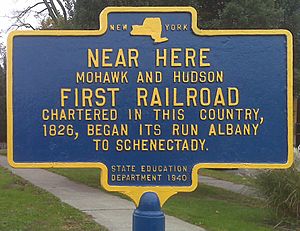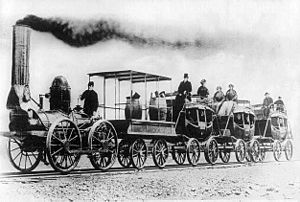Albany and Schenectady Railroad facts for kids
The Mohawk & Hudson Railroad was the very first railroad built in New York State. It was also one of the earliest railroads in the United States. It got its name because it connected the Mohawk River at Schenectady with the Hudson River at Albany.
The main idea behind this railroad was to help passengers on the Erie Canal travel faster. They could use steam trains to quickly go around the Cohoes Falls, which was a long and winding part of the canal journey.
The railroad company was officially started on April 17, 1826. It began carrying passengers on August 9, 1831. Later, on April 19, 1847, its name changed to the Albany & Schenectady Railroad. Finally, on May 17, 1853, this railroad joined with the larger New York Central Railroad.
Contents
History of the Mohawk & Hudson Railroad
Starting the Railroad Idea
On December 28, 1825, a man named George William Featherstonhaugh from Schenectady County put an announcement in the newspaper. He shared his plan to create the Mohawk & Hudson Rail Road Company. His goal was to build a railroad that would bypass the Erie Canal route between Albany and Schenectady. This would cut the travel time from a whole day to less than an hour! Because of his efforts, the Mohawk & Hudson became the first railroad in New York State to get an official charter on April 17, 1826.
Building the Tracks
Construction of the railroad began in August 1830. The line officially opened on September 24, 1831. It was a 16-mile route connecting Albany and Schenectady. The tracks went through the Pine Bush area, which is a unique sandy region between the two cities.
A civil engineer named Peter Fleming first planned the route and estimated the costs. He left in 1830, and John B. Jervis took over his role. The tracks were made of flat metal strips called strap rail. These strips rested on large stone blocks instead of the wooden crossties we see today.
At first, the railroad tracks ended outside of both cities. This was done to avoid very steep hills. In Albany, for example, the line stopped near where Madison and Western Avenues are now. Passengers would then finish their journey into the city by riding in horse-drawn stagecoaches. Later, special inclined planes were built at each end of the line. These were like ramps with powerful steam engines that would pull or lower the trains up and down the steep parts.
The First Train Ride
The famous DeWitt Clinton locomotive was built by the West Point Foundry in New York. It had its first test run on July 2, 1831. After some thought, it was decided that the engine would burn wood for fuel instead of coal.
The official opening day was September 24, 1831. About eighty important people, including politicians, were there. The DeWitt Clinton locomotive pulled three passenger cars. It completed the 16-mile journey in just forty-seven minutes! Eight other cars had to be pulled by horses because the locomotive couldn't pull them all.
A Rider's Experience
In 1832, a person riding the train wrote about their experience in a journal. They said:
June 28, arrive in Schenectady. Among the astonishing inventions of man, surely that of the locomotive steam engine hath no secondary rank. By this matchless exercise of skill, we fly with a smooth and even course along once impassible barriers, the valleys are filled, the mountains laid low, and distance seems annihilated. I took my seat as near as possible to the car containing the engine, in order to examine more minutely the operation of this, to me, novel and stupendous specimen of human skill. Having thus, as if by some invisible agency flown the distance of 16 miles in 40 minutes, at Schenectady I took passage on the Hudson and Erie Canal for Buffalo.
This quote shows how amazing people thought the steam engine was. They felt like they were flying and that distances were no longer a problem.



